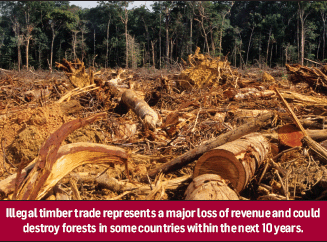Hardwood 101: illegal logging - Demand that your suppliers import from lawful sources
Anderson Hardwood Floors
Every day that we do nothing, overseas suppliers to our industry will illegally strip more than 100,000 acres of old growth forest. By not being familiar with the illegal practices of those suppliers, primarily the ones in the Far East, you may be unwittingly doing irreparable harm to the world’s forest and supporting one of the greatest environmental disasters of this or any other time.
Ten thousand years ago, half of the Earth’s surface was covered with trees. Today, there are only about 10 billion acres of forest left on the planet. And, of those that remain, about 3 billion acres are moderately to severely depleted. With illegal logging practices becoming commonplace in many countries around the world, it is more important than ever to find ways to bring equilibrium to an industry wrought with chaos and corruption.
Illegal harvesting procedures are defined as those using corrupt means to gain access to area forests, extraction without permission or from a protected area, the cutting of protected species or the extraction of timber in excess of agreed limits. In addition, most outlaw loggers do not make the necessary attempts to regenerate the areas they pillage, damaging these sections of land permanently.
It is estimated that illegal timber trade comprises over a tenth of the global timber market worth more than $150 billion a year. It is likely that at least half of all logging activities in particularly vulnerable regions—the Amazon Basin, Central Africa, Southeast Asia, the Pacific Rim and the Russian Federation—is illegal.
Illegal logging represents a major loss of revenue and a major cause of irreparable environmental damage. Countries like Indonesia, the Philippines, Cambodia and Congo report billions of dollars in lost revenue each year due to illegal logging practices. In many of these countries, illegal logging could destroy all local forests in as early as 10 years.
In 1998, China imposed a ban on logging after excessive clear-cutting induced a series of massive floods from the Yangtze. This ban has slowed the destruction of China’s forestland, but it has in turn forced China to meet rising demand with a massive importation effort of both legal and illegal timber.
Recent research shows that China is now one of the two major importers of Indonesian timber. With the ban on logging, Chinese corporations have been forced to shift their focus to tropical forests around the globe as a means for survival. This globalization effort has resulted in the destruction of tropical forestland in numerous poor countries seeking to make a quick buck. Not to mention occasions where outlaw loggers have either forced entry onto land or simply avoided detection by logging extremely isolated regions of foreign forests. So it appears the ban on logging in China has done nothing more than shift environmental destruction to other parts of the world.
A recent research project by Forest Trends indicates that much of China’s current timber demand is being supplied by illegal logging. A United Nations analysis of timber statistics for 2002 indicated that China’s imports of logs from Indonesia were more than 200 times higher than the figures reported by Indonesian customs. In addition, 60% of all of China’s wood imports come from Russia with an estimated 20%-30% of those imports obtained through illegal means.
With Asian mills importing large volumes of illegally obtained timber, it makes sense for American suppliers to demand that the products they import are from legal sources. The Legal Timber Protection Act, currently in the U.S. Senate, will require verification of all wood sources to legally enter our country. This bill is needed to keep American consumers from unknowingly financing one of the greatest environmental disasters of our time.
Most people would not buy a stolen car to get a cheaper price. Why should it be different for wood floors?”
 |
Related News
Friday, April 26, 2024
By Emily Hooper Though the resilient category isn’t in the clear just yet, conditions are improving— as much as the flooring industry can improve in this economy. In this case, improving means 2010 may be the end to a consistent drop in category sales since 2006...read more
Over the last nine months, the flooring operations at Invista have undergone a number of major internal changes, from being separated into its own operating division to having a new president for the business unit that oversees it. Invista’s flooring business, now known as Surfaces, integrates its...read more
PHOENIX—The U.S. Green Building Council (USGBC) has introduced its latest green building rating system, LEED for Healthcare. The rating system guides the design and construction of new buildings and major renovations of existing ones, and can be applied to...read more
DALLAS—Quick•Step flooring and interior designer/style expert Erinn Valencich will host a national “Room Refresh” contest on the mill’s Facebook page through July 31...read more
LYNNWOOD, WASH.—The 2nd annual Northwest Market & Trade Show, an event hosted by the Washington State Floor Covering Association (WSFCA) and held recently at the Lynnwood Convention Center, was a “huge success,” according to Debbie Tott, the organization’s executive director...read more
By Steven Feldman SAN DIEGO—Against the backdrop of the first positive sales trajectory since the beginning of the Great Recession, the National Wood Flooring Association’s 26th annual convention focused on just that: How to take advantage of...read more